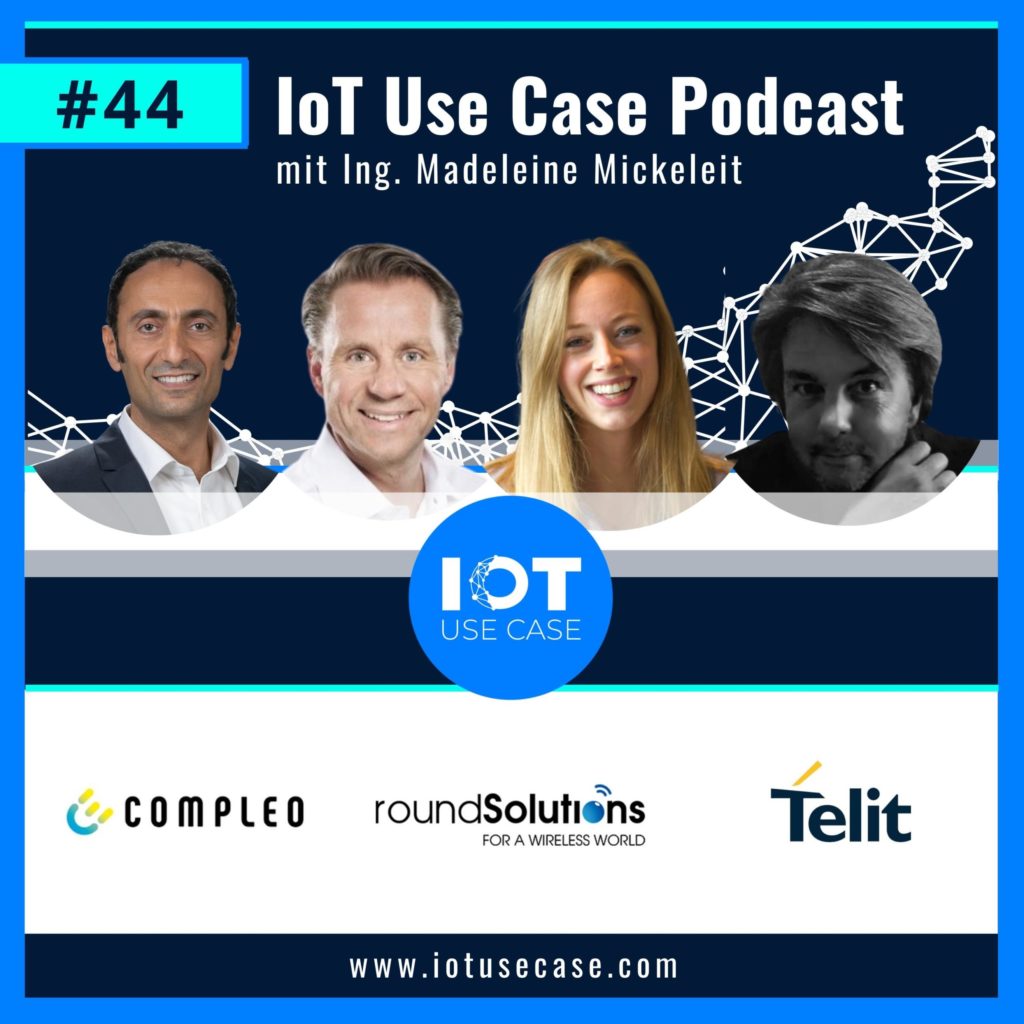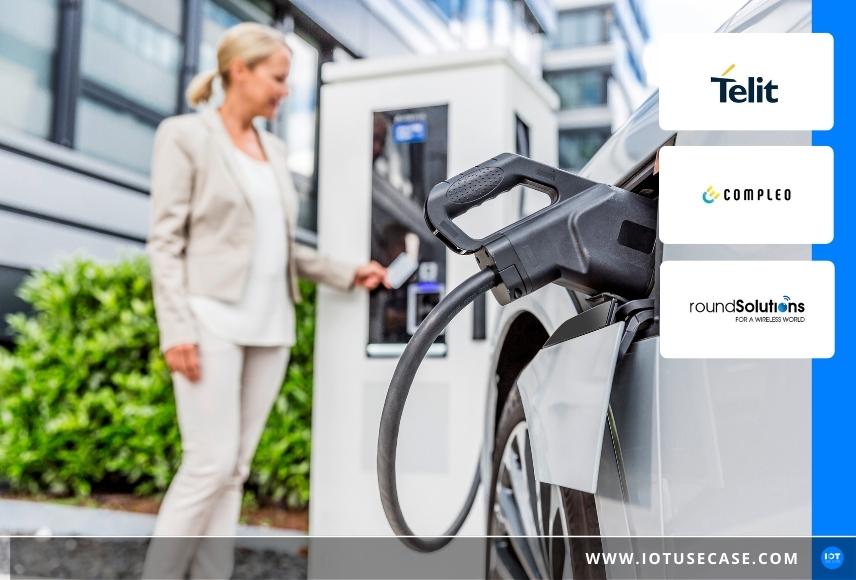“Without digitization, there is no powerful charging infrastructure in electromobility.” That’s why charging station manufacturers like Compleo Charging Solutions are partnering with IoT and connectivity providers like Telit and Round Solutions to create digital momentum. The focus of the 44th episode of the IIoT Use Case Podcast: How do today’s networked e-charging stations work and what are the added values?
The energetic guests: Paul Shelley (Senior Sales Director Central Europe, Benelux & East Europe, Telit), Ben Hoelke (Founder, Round Solutions) and Checrallah Kachouh (Co-CEO and CTO, Compleo Charging Solutions AG).
Podcast episode summary
Round Solutions is Europe’s leading supplier of modules such as LTE, NB-IoT or WiFi. Telit is known worldwide for its wireless solutions in machine-to-machine (M2M) communications. For more than 20 years, the two companies have combined their know-how and developed innovative products in the M2M sector based on wireless technologies. A common customer is Compleo Charging Solutions, a provider of charging solutions for electric vehicles. The products are AC and DC charging stations and wallboxes for companies, energy suppliers and operators. The use case revolves around the integration of the Telit module into the e-charging stations and the benefits this creates for providers and end users.
The Compleo charging stations are equipped with a cellular module from Telit, which – if you were to compare it to a car – acts like the engine of the whole thing. Integrated on a circuit board in the controller or in a modem, it allows sending the data to the cloud, which is recorded by a (micro) controller or processor.
What data is relevant here and for whom? Mainly there are two types of data: Availability data and billing data. The availability of the charging infrastructure is the be-all and end-all – is the charging station free, is there perhaps an error message and if so, what is not working properly? In addition to the end user, this data is particularly important for the so-called charge point operator, the CPO. Billing data is primarily critical for the electric mobility provider, the EMP, as it enters into the charging contract with the end user and provides them with an RFID card or access app for charging authorization.
A charging station is only as good as its connectivity: That is why permanent network availability must be guaranteed. It is usually impossible to predict where a charging station will be placed, which is why flexible and automatic network changes are essential. The solution: Telit NExT. In collaboration with mobile network providers, this web-based management tool closes network gaps and offers round-the-clock service, among other things. Telit is in the midst of a transformation: from a pure hardware manufacturer to a hardware software and service provider.
Podcast interview
Hello Checrallah, hello Paul and hello Ben, welcome to the IIoT Use Case Podcast. I am very happy that you are with us today, that you have taken the time for this exciting topic and also about the exciting constellation today. I would just start right off with a round of introductions and then jump into your collaborative project or use case. Paul, I would just turn the floor right over to you. Could you say one or two points about yourself and briefly tell us what Telit does exactly in terms of its core business?
Paul
With pleasure. Thank you very much for letting me be a part of it. My name is Paul Shelley, I am Senior Director Sales at Telit and responsible for Benelux and all of Eastern Europe. My background is in Industry 4.0, with a focus on automation, artificial intelligence, that is where I come from. Everything related to ICC and GMIs is my background and I have been with Telit for 1 ½ years now. To give a brief insight into the world of Telit: We are a publicly traded company listed on AIM in London and we were founded in the 1980s. Our Head Court is in Trieste and there we also have R&D (Research and Development) and all the technical development. Thus, we are a European company. Our doctrine in the next few years is to put the mindset on the customer and to offer even more service in finance, technical service and also availability.
Very nice. Then I would hand over directly to Ben. Do you like to join right away and also say a point or two about yourself and what Round Solutions does from a core business standpoint?
Ben
Yes, thank you Madeleine. Round Solutions was founded in 1999. So I started the company over 20 years ago and we have three functions, you could say. From day 1 we were focused on M2M (machine to machine) then, now IoT and we have a distribution function where we have been working closely with Telit since the early 2000s. We use Telit modules and devices for our own developments and that is then the second function. So we develop on behalf of customers and also manufacture our own IoT devices and gateways.
Perfect. Yes, you probably have to explain the compositions a bit at the beginning. The bottom line is that you are the distribution partner on the part of Telit, as you said, you are deploying the modules and you have now brought a common customer here – that is the Compleo CS company. That’s where I would hand it over to you, Checrallah. Would you also like to introduce yourself and what exactly you do in terms of core business?
Checrallah
Yes, thank you Madeleine also from my side. It’s really great that we’re coming together here today. Checrallah Kachouh is my name. I am co-CEO and CTO at Compleo Charging Solutions. Compleo is a provider of innovative charging solutions for electric vehicles. I have been working in the field for 12 years when we started this venture back then. We are now a leading supplier in the market. We have both AC and DC charging stations in our product portfolio. Our major customers include blue-chip customers, Telekom, Deutsche Post, Siemens, major automotive manufacturers, food retailers and more than 150 municipal utilities. We offer quite a broad portfolio of products. Many charging stations in many cities come from us and there we are looking at a very strongly growing market in which we also play an important role. One more information, we are listed since October 2020 and we are also growing fast accordingly and now recently announced that we are acquiring 100% of the shares of wallbe and after the closing, after the merger, we will be over 320-330 employees.
Very exciting. I would also go back to your customer(s) in detail right away and ask follow-up questions. Perhaps to introduce the listeners a bit thematically: We are now talking about the topic of e-charging stations, which is a major and also political topic – the expansion of e-charging stations in Germany and Europe alone. I think there are 40,000 different charging stations in Germany alone, you read a lot about it. Can you tell us a bit about the relevance of the topic and the development of charging stations in general, and then perhaps also what relevance digitization has for you exactly in the course of this?
Checrallah
We are on the verge of a major mobility shift. We are experiencing this together – it is visible in the press, in all that the entire automotive industry is doing, and it is very exciting to see how the new vehicles will turn out as well. And this energy transition, this electromobility transition, will only succeed if there is also sufficient charging infrastructure. Because the cars have to be charged and this charging infrastructure has to be seen differently. There are several use cases. Some are open to the public, in public spaces, some are at work, some are at home. There are also different charging capacities: AC charging – the somewhat slower charging, DC charging – fast charging – and these different use cases also have different requirements for digitization. But you can say that without digitization, there is no charging infrastructure. So no powerful charging infrastructure. This can perhaps be explained well with the following procedure: If you are standing at a public charging station and want to charge, you have to authorize and authenticate yourself. The charging station is connected to backend systems, to cloud-based solutions, which then check or transfer this authorization, charging takes place, billing has to take place, data always has to be transported back and forth. Operations also have to be ensured and so you have a lot of information and communication technology and all of that information has to be transported and you have to have the right channels to do that. Regulation is a key function in having the charging infrastructure perform for the future.
You said that there are different use cases, whether I have this charging station in front of my door at a large company, for example, or directly in the city. What do I actually need to put a charging station like this into operation? What exactly does charging infrastructure mean in practice?
Checrallah
A wallbox is also a charging station. It is electrically connected, on site at an electrical installation. That’s where the energy comes from. And then you have a charging station – to stay with the example of publicly accessible charging infrastructure – it has means of authorization and authentication. I can do this via an RFID card that I hold in front of the charging station, or I can use my smartphone to authorize myself accordingly via my provider’s app. Then you need a backend system, we’re talking about CPO backend, so that’s the charge point operator, that’s who operates the charging station, they have a platform that they use to monitor the charging infrastructure and process the authorization requests, forward them and also the billing data. He passes those on to another role, which is the EMPS role, which is the electric mobility provider. That’s who you get a charging contract from as an end user. With him you conclude a charging contract, also get an authorization means, for example, the RFID card or the app, and thereby get access. The role of the EMPS is to make sure that you can charge at as many, or ideally all charging stations that are accessible when you are on the road. And so you have an ecosystem consisting of the charging infrastructure, the charging pole themselves, the charging stations, the embedded software that’s in there, the connection to a backend system, the CPO backend, then you have the EMP role to that, which the end customers have, and it enables charging, and there are also roaming platforms that you need to connect as well. There are multiple CPOS, meaning multiple charging infrastructure providers, and multiple charging contract providers, meaning multiple EMPS. And connecting them together, that’s what roaming platforms are for – and for me that’s the complete charging infrastructure.
Now we are talking specifically about the topic of IoT in the podcast. The bottom line is that we are now talking about live data that comes from these charging stations and is somehow connected to the cloud. Now you had just said there is both a backend and an application. How does it work directly at the charging station now? What do I need to be able to communicate with the cloud in the first place? There’s probably hardware installed somewhere, with an IoT SIM card pumping up the data somewhere. The question for me would be, what data is classically interesting for you here, which then flow into this app?
Checrallah
A modem is usually installed in the charging station. A 4G modem is now currently the case with us. We obtain this modem through Round Solutions from Telit and there are two types of data: this is this live data, as you just mentioned, this is data to monitor the charging infrastructure and also to relay the information, which ones are freely available and which ones are not. One would like to recognize, if one drives with the car, already at its destination, is the charging station there, is it functional and also available. Ideally, you want to book them in the future as well, and all of that requires a lot of communication between the different participants in that ecosystem. The second category of data is the billing data – how much is charged. I mean, you can imagine, in the future, this business of charging electric road vehicles will be very relevant. There is a migration of customers, a migration from mineral oil to electricity, and there is great business potential there, and these accounts and accounting data, they also have to meet high requirements. They have to be correct, they have to be accurate, they have to arrive reliably via the various market participants to the end customer, who gets his bill in the end. It’s all implemented through these interfaces, these communication interfaces.
Now you had just talked about two different types of data. One was the live data, perhaps also a bit for monitoring, the other was the availability, which also has a relevance, and the billing data. Perhaps asked again on point 1, the live data for monitoring – exactly what types or what data is of interest to whom in this stakeholder group. You had now described different roles as well. Are these also service issues? Or what kind of data do they monitor there anyway?
Checrallah
So the first category is about the availability of charging infrastructure. If the charging station is functional, if it has any error messages. If there are errors, what type of errors. One would like to have as little effort as possible in the operation of the charging station. That’s why you collect data and also want to get it as quickly as possible, so that availability is high and you have as little effort as possible. When you go somewhere to repair a charging station, you want to know in advance exactly what kind of component is defective, that you have it with you, and that you only have to make one trip to the charging station to repair it. It’s even better if you can do a repair remotely, if certain things can be improved via software, by doing a software update. This is also possible via this. That’s this service role.
That is, you are also thinking in the direction that by sharing this data of the charging station itself, you also involve third parties, such as service providers or the like, so that they know, for example, when a fault is likely to occur?
Checrallah
Yeah, so the thing that we share, so what the CPOS share, and they’re very happy to do it, is the availability of the charging stations so that everybody knows, there’s a charging station there, where is it exactly. You’re going to have static and dynamic data so that the utilization is as high as possible to make the business worthwhile. After all, it doesn’t do me any good if I have a charging station and no one comes by to use it.
Ultimately, this is also the data that goes to Tesla & Co., where in the best case, as you just said, the data is also made directly available to the customer as to where the next charging station is free. Now we’re also talking to Round Solutions and Telit today in this context. How do you choose these modules today? After all, this is probably also customer-specific. How does that work from your side, when do you sort of hand over to Round Solutions, and what else do you do today regarding the different customer requirements by yourself?
Checrallah
The components we have in the charging station support communication technology in general, there are control units in there and communication modules. When selecting communication modules, we make sure that the modules meet the exact requirements, the issue of reliability, the issue of availability of charging stations and thus also of communication technology is elementary, and so we look at the market to see what offers are available, what is the price-performance ratio, and then we make our decisions on that basis. These are also products that have to be available for a long time because, on the one hand, we have to ensure reliable production going forward. The number of charging stations is growing, there is a need for many. Currently and in the future, this is becoming more and more and we must be sure that we are also reliably supplied, we must be sure that we also get spare parts when needed. So that’s a set of criteria and that’s also how we decided in the past to work with Round Solutions and with Telit’s technology because that convinced us.
Ben, can you tell the listenerns a little bit about what a module like this even means? What is it? How does it work?
Ben
I think if we’re talking about a cellular module, which is what we’ve talked about here now as a base, you could say that if the complete device is a car, then the engine would be the Telit module and Telit works with a chip manufacturer, Qualcomm as an example, an American company, and Qualcomm would sort of make that engine block, so to speak. But you have to imagine it like this, the silicon comes from Qualcomm and Telit builds a module there, which you then integrate on a circuit board in the controller or in a modem and that enables you to send this data. So record from a controller, from a micro-controller or a processor and send those to a cloud, for example. And there are then again different decision criteria, how much data is to be retrieved, which is to be uploaded, and therefore there are, so to speak, different engines of LTE and now on the way to 5G.
The module, as I understand it, is in effect the circuit boad. I think one or two of you have seen this before, these are basically these green circuit boards that you first have, and then I have the chip somewhere and then I probably still need the IoT SIM card somewhere that is inserted or soldered in there, right? I don’t know the details, but it comes from a certain provider and then sends the data to the cloud via cellular. Is that how it works?
Ben
Yes, you could say that. The circuit board contains a lot of components and the cellular module is a very important component that is placed on a circuit board.
Now Checrallah had just said there are diverse requirements that are made by customers. It would be interesting for me to know how to select the right module, because as a customer I don’t want to deal with the details of what amount of data and what frequencies are needed which are transferred into the cloud. In the end, that’s your part. How do I select such a module correctly and according to which criteria?
Ben
Yes, we have already mentioned that there are two possibilities. One is that the customer, in this case Compleo, for example, has a very competent development department and has been working on this for a very long time. We have been supplying Compleo for almost 10 years and they have a great deal of know-how. That is one option. So where we then act more in the background as support, that can be a design review, that can be as a sparing partner, that can also be, if any problems arise, then we are ready in the background to also help the customers with our own engineers or also together with Telit. And then there is the other variant, where the customer’s know-how is not yet quite so great, and there is a criteria catalog. This download and upload speed is a very important question, and availability, i.e. network availability, is extremely important, and this raises the question of the geographical deployment of this device. Is that in Europe? In Europe, we have standardized frequencies. None of that is an issue, but North America, for example, has different frequencies than Europe in some cases. Asia or China have different frequencies. There are some exotic countries like Japan, Korea, partly Australia, etc., so geographically is an issue and then there is also the issue of how much space do I have on my board. Such a module is about 10 mm x 10 mm, roughly speaking, and there are applications and we can imagine this as in a smartwatch, where I need an extremely small module and for similar applications, where I have a bit more space, I can then perhaps take a larger module. A larger module usually also means somewhat greater flexibility in terms of different modules to choose from. Because, as I said, there are also different radio technologies that you can choose from, and that also has to do with speed.
Checrallah, maybe a quick interjection before I get right to you, Paul, and connectivity maybe a bit. Now you hear the topic of 5G more often in this context, so how is the relevance of the topic of 5G with network coverage to be understood here? Is that an issue or is that something that doesn’t matter there now?
Checrallah
So the charging station application doesn’t need as much of those capabilities that 5G brings. What is elementary for the charging station is availability. We had experienced this in the past from 3G to 4G. The availability of the network is then also very important. The background is that when you get to a charging station and you want to charge and you can authorize via your app, the charging station has to be available online, otherwise I can’t start the charging process. The consequence is on the one hand a loss of business for the operators, but also the customers are very annoyed. And that’s why availability is the key. The amount of data is not that high. We manage wonderfully with 4G. And it may be that things will continue to develop in the future. Now there are certainly applications like if you want to upload an advertising video to a charging station, depending on the customer who is there, then I can imagine that you need something like that in the future, but in the mass it is about availability and if a 5G gets a higher availability in the future than a 4G network, 5G will also prevail at many charging stations.
That means that there is also the case that there is no network or that a charging station is not available? Then you have to make sure that you switched to another network probably, right?
Checrallah
Yes, exactly. And that’s one of the criteria for selecting the components. There are SIM cards inside the charging stations, we can’t predict in advance where the charging station will be installed. Sometimes you can, but across the board it’s not possible. If the market then continues to grow, even less so. That’s why you need components that automatically switch from one network to another. They check which network is best available and also SIM card technologies, modules, etc. that support this in order to get there.
Paul, now Checrallah had just said it’s about automatic switching. I’m talking about the issue of connectivity now – how does the data actually get to the cloud? We have now learned a lot about infrastructure. Now we are talking about automatic switching from different networks. How does that work in general? I now imagine a piece of hardware and I now have the cloud somewhere. How does the data get into this cloud? What does connectivity look like there?
Paul
IoT is the Internet of Things, and ultimately it is the networking of applications, machines, and sensors, which are then connected to the Internet. Here, the data is collected by the application and sent to the cloud via the cellular network, as is familiar from cell phone use. Of course, you can also use the opposite way and control and monitor the machine via an app or a cloud application. For example, alarms or when a threshold is exceeded. And to ensure data security, protocols for encryption or virtual private networks are used. In addition, you can use special SIM cards that are intended for the industry and they are similar to a normal SIM card, but ultimately produced for the industrial sector.
When I imagine a charging station like this now. How does that work with the switching of the individual providers?
Paul
I think that has something more to do with steering. And it is this that makes the difference from a contract in the area of connectivity that we offer. We don’t have that steering. It’s important to us not to charge for units, it’s important to us to maintain connectivity for the customer. There are also, for example, very difficult environments, if we now go in the direction of North America, for example. And the customer has a contract with Horizon, which will obviously have gaps, radio holes. This application is probably even solved with two SIM cards.
And what digital services does Telit now offer its customers there? So those are then digital services that you need to enable that there? Or what services do you generally offer in this regard?
Paul
We offer Telit NExT. That’s a solution where we’re also working with MNOs (mobile network operators) to fill in all these gaps. That the customer remains constantly connected and thus eliminates precisely these radio gaps. We now offer various building blocks. We don’t just offer the hardware, we offer the SIM cards, we offer a management platform and the hardware. Telit has changed or is changing a bit. We are changing from a pure hardware manufacturer to a hardware software and service provider.
In other words, the relevance of this management platform is that I can use a wide variety of services on the platform to manage these SIM cards and these devices that are somewhere in the field. I guess that’s the background, right?
Paul
Yes, absolutely. What we offer with this connectivity service is a web-based management tool. It’s very intuitive, and of course it gives you a better overview of your account and the individual SIM cards, so we offer a comprehensive package of services that is very unique. The whole thing is of course coordinated with our own radio modules and what is important, the technical support. This is a technical support that is behind it, and is available around the clock. I now compare this a bit with a telephone contract. There it really is that you get support 24 hours a day. And I think that’s also really, really important. Especially if you produce anything and you have an outage, you can’t wait until 8 or 9 o’clock in the morning for the gentleman or lady to be back on the hotline to help you. That’s the difference from IIoT or IoT connectivity to the commercial in the industrial sector.
Checrallah, once again a question in your direction: These are now very different competencies that perhaps also complement each other here. What competencies do you bring to the table and how does the collaboration work in such a project? You have to rely on a wide variety of technologies and are perhaps also looking for good partners, but what skills do you bring to the table and how does the collaboration with projects like these work?
Checrallah
Yes, so as Ben said at the beginning, we have a lot of development experience in the development of the products and so we are able to put the modules from Telit directly on the controllers, on our charging station controllers with us and integrate very well. So we have a very well functioning charging station with its communication modules. The SIM cards that are installed in our charging station come from different sources, because our customers, often the CPOS, have different back-end systems and we have the requirement that our charging station works smoothly with all back-end systems of the CPOS in Europe. And so we then receive SIM cards and the charging stations are then already configured accordingly, so that they therefore fulfill the requirements when they are delivered. So much for that point. And if we supply our own SIM cards, which there are, for some customers we have the option of offering our own back-end system for a special customer group as well, and there we have SIM cards selected by a partner with whom we work. There we have put emphasis on the fact that the contract with the SIM card allows the charging station to automatically dial into different networks, and this can be thought of as the module automatically recognizing which network is most available at the location and automatically dialing into that network. This is very important for us to satisfy our customers.
I think this is also just a nice project in general to understand the composition in the first place. Firstly, the relevance, which you had also explained at the beginning with the reliability, the requirements that come with such modules and charging stations, and then secondly also the deep dive into the technology of the whole networks, how that works in detail. Really super exciting for many who may also be in the field right now and looking for technologies. Finally, a general question: What further potential do you see for your business in the future through such digital approaches? You said you could also do marketing on these charging station concepts, so maybe that’s one approach. But what else is coming there now as a result of digitization in the future? What are the digital approaches, digital business models perhaps, that go along with that?
Checrallah
Yes, so I think these digital business models are developing not only with us, but also with our customers. So in the chain, there are many. And as far as we are concerned, we want a reliable charging infrastructure, i.e. a charging station that provides as much data as possible about its condition. But we also need to ensure billing, which means we need reliable billing data. That’s what our charging station has to deliver, and that’s how we differentiate ourselves. We have technologies there, too. So the issues of quality of billing data and availability. For our customers, on the other hand, it is very important for them to know, of course, which charging station is used most often and where charging stations will be needed in the future. There is advance planning that takes place at our company and studies that make predictions, but in the end, what matters is that the charging stations are used as often as possible in reality. In the case of gas stations, it’s like this: Today, there are 15,000 gas stations in Germany, i.e. liquid fuel stations, and they are located exactly in the places where you get the most revenue. This has been optimized over time.
Ben, maybe the question now again in your direction. We have now taken the example of charging stations as a use case, on the basis of which the listeners understand the hardware and module selection on the one hand, but then also the connectivity in the cloud, and the SIM card issue and also the management on the platform. Now, there are listeners out there who may come from a different background. You are active across all industries with the Telit modules. What other use cases are there? Is this use case transferable 1:1 or where are you headed with this?
Ben
Yes, in recent years we have already been very strong in the industrial sensor world. This simply resulted from the fact that we work together with sensor manufacturers and we are now very familiar with this vertical area of industrial sensor technology. There is the keyword IO-Link, a protocol that is really extremely customer-friendly and effective for industrial sensors, because it is a bit like a USB for the PC, so IO-Link is the counterpart for an industrial sensor. This is a vertical market where we have now built up a great deal of expertise in recent years, but otherwise it is just as you said, we are a technology provider and that means we also have projects outside this typical example now of industrial sensor technology.
Yes, I think that came out very nicely in the session as well. Thank you for this exciting round!















